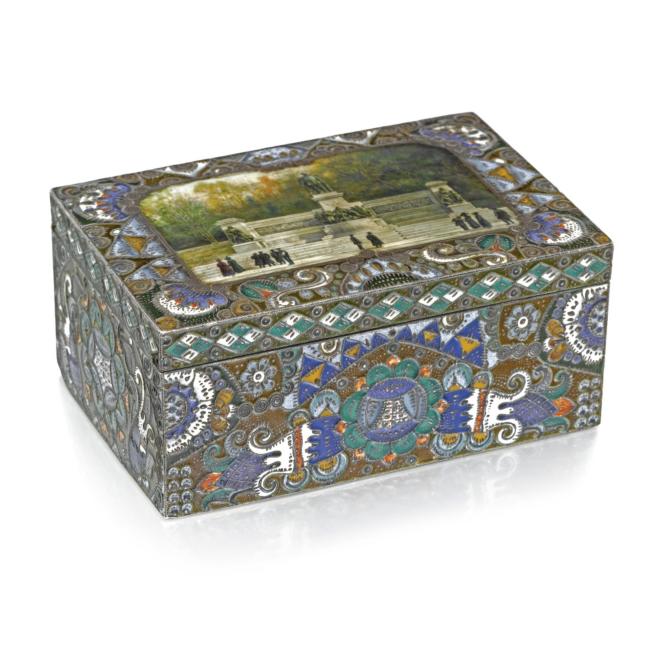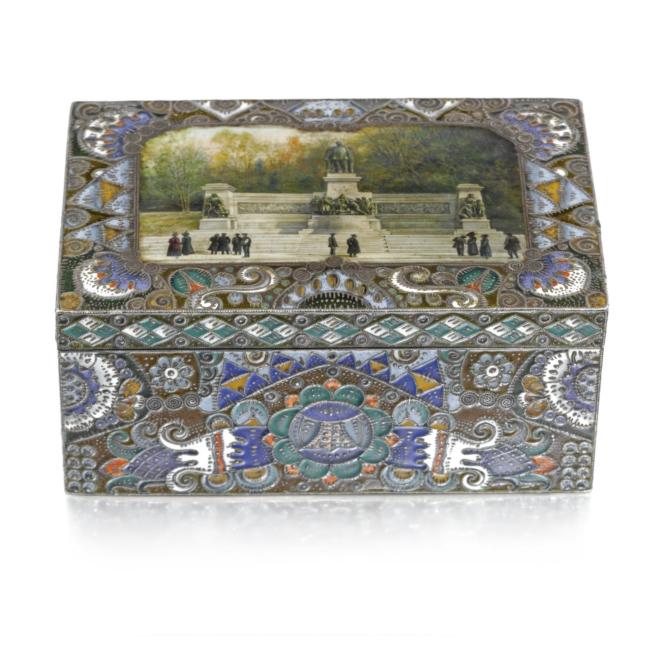Работы Рюккерта, проданные на аукционе Сотбис




Russian Works of Art, Fabergé and Icons
Sale: L11113 | Location: London
Auction Dates: Session 1: Wed, 08 Jun 11 10:00 AM
Sale: L11113 | Location: London
Auction Dates: Session 1: Wed, 08 Jun 11 10:00 AM
LOT 446
30,000—50,000 GBP
A RARE SILVER-GILT AND ENAMEL PICTORIAL BOX, PROBABLY FEODOR RÜCKERT, 1911, COMMISSIONED BY MARSHAK, KIEV
30,000—50,000 GBP
A RARE SILVER-GILT AND ENAMEL PICTORIAL BOX, PROBABLY FEODOR RÜCKERT, 1911, COMMISSIONED BY MARSHAK, KIEV
Measurements
width: 12,2cm, 4 7/8 in.
Description
rectangular, the lid painted en plein with a view of the monument to the 'Tsar Liberator' Alexander II in Kiev, admired by spectators in the foreground, the lid border and sides with shaded stylised flowerheads and geometric motifs on vari-coloured grounds, the surface further decorated with cloison coils and granulated tendrils, gilt interior, the base struck I. Marshak in Cyrillic, 88 standard
CATALOGUE NOTE
The grand monument to Emperor Alexander II in Kiev was dedicated on 30 August 1911 to commemorate the 50th anniversary of the Emperor's emancipation of the serfs in 1861. It was the largest of such projects in the Empire. Over 200,000 people had contributed to the building fund, and an international competition for the commission began in 1910, the prize awarded to the Italian sculptor Ettore Ximenes (1855-1926). The design was centred on a large full-figure bronze of the Emperor on a pale pink granite pedestal inscribed 'To the Tsar-Liberator from the Grateful South-Western District in 1911' above a figural group of serfs. Curved pediments were set with bronze reliefs sculpted with scenes from the Emperor's reign, flanked by allegorical figures of Justice and Mercy. The monument was erected at the head of Khreshchatyk Street on Tsar's Square (now European Square). Following the Revolution, the bronze work was destroyed in 1920; the stone pedestal remained for another decade, serving as the gateway to Proletarian Garden (now Kreshchatyk Park), until it too was pulled down. (Sotheby's is grateful to Ms Mari Stock, Kiev, for her assistance in providing this research.)
Emperor Nicholas II was present in Kiev for the dedication of the monument, which occurred just days before the assassination of Prime Minister Pyotr Stolypin at the Kiev Opera House in front the Emperor and his two eldest daughters. The Kievan jewellery firm of Marshak was commissioned by the district council to produce gifts for the Imperial visit; the firm's proprietor, Joseph Marshak, and his craftsmen spent a year preparing. Among such gifts recorded is the silver model of the Pedagogical Museum at 57 Volodymyr Street which, like the monument to Alexander II, was dedicated during the visit; the silver model was given to the Tsarevitch. It is almost certain that the present lot was also among the gifts produced for the visit, and it is probable that it was given to the Emperor or a member of the Imperial Family.
Marshak is known to have retailed objects made by Rückert in the early 20th century; the firm had a similar arrangement with Ivan Britsyn during this time, just as Rückert sold through Ovchinnikov and Kurliukov. A table box bearing both Rückert's maker's mark and Marshak's retailer's mark, painted after Vaznetsov's Warrior at the Crossroads, is illustrated, A. Odom, Russian Enamels, 1996, no. 99, p. 203, and is now in the Walters Art Museum, Baltimore. A cigarette case bearing the Marshak mark and undoubtedly the work of Rückert sold, Sotheby's New York, 10 December 1974, lot 227. A Marshak box in the same style is illustrated, G. Hill, Fabergé and the Russian Master Goldsmiths, 1989, no.112, p. 114. Both of these latter objects are painted after Vaznetzov's Czarevitch Ivan and the Grey Wolf. The popularity of Rückert's work in Kiev is unsurprising given the usual subjects depicted: romantic bogatyrs of Kievan Russia.
The rendering of the architecture of the monument on the present lot bears a strong resemblance to that on the beaker produced by Rückert and presented to Carl Fabergé in 1912 to mark the 25th anniversary of their professional collaboration (widely illustrated and exhibited, including G. von Habsburg and M. Lopato, Fabergé: Imperial Jeweller, 1993, no. 219, p. 336), which is painted with the façade of the Fabergé shop in Moscow. Given this resemblance and the proximity of the dates, one can assume the central en plein enamelling on both objects was done by the same skilled hand in the Rückert workshop, entrusted by the master with his most important commissions. The present lot is appearing at auction for the first time since it was made exactly 100 years ago.
